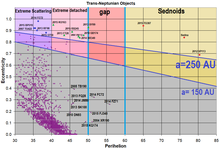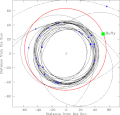(612911) 2004 XR190
Perihelion 51.110 AU | | |
| 57.255 AU | ||
| Eccentricity | 0.1073 | |
| 433.24 yr (158,242 d) | ||
| 277.05° | ||
| 0° 0m 8.28s / day | ||
| Inclination | 46.794° | |
| 252.40° | ||
| ≈ 4 April 2117[8] ±1 month | ||
| 285.56° | ||
| Physical characteristics | ||
Mean diameter | ||
(612911) 2004 XR190, nicknamed Buffy, is a
Discovery and naming
2004 XR190 was discovered on 11 December 2004.
The object was nicknamed "Buffy" by the discovery team, after the fictional vampire slayer Buffy Summers, and the team proposed several Inuit-based official names to the International Astronomical Union.[3]
Orbit and classification

2004 XR190 orbits the Sun at a distance of 51.1–63.4
It belongs to the same group as
The object is the largest object with an inclination larger than 45°,[15] traveling further "up and down" than "left to right" around the Sun when viewed edge-on along the ecliptic.
Most distant objects
2004 XR190 came to
Physical characteristics
With assumed albedos between 0.04 and 0.25, and absolute magnitudes from 4.3 to 4.6, 2004 XR190 has an estimated diameter of 335 to 850 kilometers; the mean arrived at by considering the two single-figure estimates plus the centre points of the three ranges is 562 km, approximately a quarter the diameter of Pluto.[7][9][10][11][12][13]
As of 2018, no well-documented
Gallery
-
Orbital diagram of 2004 XR190 (Earth's orbit in the center is for scale)
-
Side view of 2004 XR190's orbit, showing its highinclination
See also
Notes
References
- ^ a b c d e f g h i "2004 XR190". Minor Planet Center. Retrieved 13 December 2018.
- ^ IAU Minor Planet Center. 12 December 2005. Retrieved 13 December 2018. (K04XJ0R)
- ^ a b c Maggie McKee. "Strange new object found at edge of Solar System". New Scientist. Retrieved 13 December 2018.
- ^ a b c d e "JPL Small-Body Database Browser: (2004 XR190)" (2017-09-01 last obs.). Jet Propulsion Laboratory. Retrieved 13 December 2018.
- ^ ISBN 3-540-71957-1.
- ^ .
- ^ a b c d e f Johnston, Wm. Robert (7 October 2018). "List of Known Trans-Neptunian Objects". Johnston's Archive. Retrieved 13 December 2018.
- 3-sigma.)
- ^ S2CID 10782167. Retrieved 13 December 2018.
- ^ S2CID 15588453. (Discovery paper)
- ^ a b c d Brown, Michael E. "How many dwarf planets are there in the outer solar system?". California Institute of Technology. Retrieved 13 December 2018.
- ^ a b c "2004 XR190". AstDyS-2, Asteroids Dynamic Site. Retrieved 18 August 2019.
- ^ a b c d Dan Bruton. "Conversion of Absolute Magnitude to Diameter for Minor Planets". Stephen F. Austin State University, College of Sciences and Mathematics, Department of Physics, Engineering and Astronomy. Archived from the original on 23 July 2011. Retrieved 15 August 2019.
- ^ 2021 occultation
- ^ "JPL Small-Body Database Search Engine: H < 6.5 (mag)". JPL Solar System Dynamics. Retrieved 27 March 2014.
- ^ "Horizon Online Ephemeris System". California Institute of Technology, Jet Propulsion Laboratory. Retrieved 23 March 2009.
- ^ "List of minor planets more than 57.0 AU from the Sun". AstDyS-2, Asteroids – Dynamic Site, Department of Mathematics, University of Pisa, Italy. Retrieved 13 December 2018.
External links
- MPEC 2005-X72 : 2004 XR190, Minor Planet Electronic Circular, detailing discovery
- Discovery webpage by research team
- Canada-France-Hawaii Telescope Legacy Survey
- List Of Centaurs and Scattered-Disk Objects, Minor Planet Center
- (612911) 2004 XR190 at AstDyS-2, Asteroids—Dynamic Site
- (612911) 2004 XR190 at the JPL Small-Body Database




